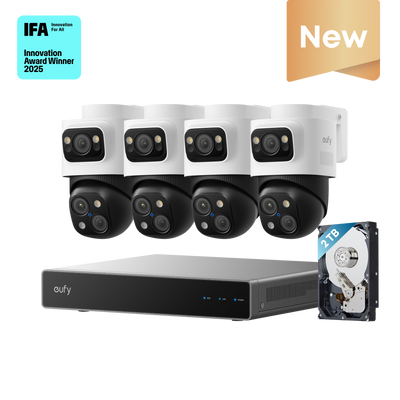Choosing the right video resolution can change how we experience media and security footage. From small screens to large displays, clarity and detail matter more than ever. Understanding SD vs HD helps you make smarter decisions when selecting cameras or streaming content. Even subtle differences in resolution can affect how clearly you see colors, shapes, and motion, shaping both convenience and overall viewing satisfaction.

What is SD Resolution?
Standard Definition (SD) resolution has been around for decades and was the norm for television, VHS tapes, DVDs, and early digital video formats. Resolution measures the number of pixels forming an image, displayed as width by height. The most common SD storage resolution is 720×480, but with pixel aspect ratio adjustment, it is typically displayed as 4:3 (or 16:9 in widescreen mode). Fewer pixels mean images are softer, edges blurrier, and details are harder to discern, especially on modern HD screens.
Types of SD Video Formats
- 144p:One of the lowest resolutions, offering 192×144 pixels (4:3) or 256×144 pixels (16:9). Once popular on early mobile devices, it is rarely used today.
- 240p:Around 320×240 pixels (4:3) or 426×240 pixels (16:9). Early webcams, CD videos, and old consoles used this format. Some streaming platforms still offer 240p.
- 360p:Often used for live streaming on smaller devices. Resolutions are 480×360 (4:3) or 640×360 (16:9). It provides decent viewing on phones and tablets but looks blurry on larger screens.
- 480p:The most common SD resolution in the NTSC system. At 720×480 pixels, it balances quality and file size, suitable for desktops, laptops, and tablets.
- 576p:Standard in PAL regions, equivalent to 480p in NTSC. Resolution is approximately 720×576 pixels and was common for DVDs and digital broadcasts.
What is HD Resolution?
High Definition (HD) offers greater pixel density, resulting in sharper, clearer visuals. HD resolutions start at 720 pixels in height with a widescreen 16:9 aspect ratio. HD became popular in the 2000s, first with 720p HD-ready, followed by Full HD 1080p. Movies, video games, streaming platforms, and television broadcasts now widely use HD.
Formats of HD Video
- 720p (HD Ready):1280×720 pixels. It’s ideal for online videos, social media, and HD live streams, offering quality without overloading bandwidth.
- 1080i/1080p (Full HD):1920×1080 pixels. Full HD delivers noticeably better detail than 720p, especially on larger screens. Progressive scan (1080p) provides higher quality than interlaced video (1080i).
- 1440p (Quad HD):2560×1440 pixels. Often found on monitors, gaming setups, and smartphones. Quad HD offers four times the resolution of 720p.
- 4K Ultra HD:3840×2160 pixels. Four times the resolution of 1080p, providing incredible detail, especially with UHD-compatible displays.
- 8K UHD:7680×4320 pixels. Sixteen times 1080p resolution, still rare in usage but emerging in some advanced displays.
SD vs HD: Main Differences
Understanding HD vs SD video is crucial for choosing the right format. Here’s a breakdown:
- Video Quality:HD videos have sharper images, richer color depth, and better detail than SD videos. Even the lowest HD resolution, 720p, improves clarity on modern devices.
- File Size:HD content produces larger files, requiring more storage and processing power. SD videos are smaller, making them easier to handle on older devices.
- Performance Impact:Editing HD videos takes longer and needs more computing power. SD videos render faster and demand less from your system.
- Bandwidth Requirements:HD streaming consumes more bandwidth. Adaptive streaming can help, but SD is better for slow internet connections.
- Aspect Ratio:SD uses 4:3, while HD is optimized for widescreen 16:9 displays.
- Scanning Method:The “i” in 1080i refers to interlaced scanning (lines refresh alternately), while “p” in 1080p or 720p uses progressive scanning (all rows refresh simultaneously), providing smoother visuals.
Here’s how SD and HD compare at a glance.
|
Category |
SD (Standard Definition) |
HD (High Definition) |
|
Typical Resolution |
720 × 480 (NTSC) / 720 × 576 (PAL) |
1280 × 720 (HD) / 1920 × 1080 (Full HD) |
|
Aspect Ratio |
4:3 (or 16:9 in widescreen mode) |
16:9 widescreen |
|
Image Quality |
Softer images, less detail |
Sharper, more vibrant, greater clarity |
|
File Size & Bandwidth |
Smaller files, easier to stream |
Larger files, higher bandwidth needs |
|
Performance |
Easier on older devices |
Requires more powerful hardware |
|
Common Uses |
DVDs, old TV broadcasts, legacy devices |
Modern TVs, streaming, gaming, video production |
|
Scanning Type |
Usually interlaced (480i/576i) |
Progressive (720p, 1080p) or interlaced (1080i) |
Comparing HD video vs SD video, HD generally wins on quality, while SD is more efficient in storage and bandwidth usage.
SD vs HD: When to Use SD?
SD resolution is ideal in several scenarios:
- Older Devices: If your screen cannot display high resolution, SD is sufficient.
- Low Bandwidth: Slow internet connections benefit from smaller SD files, avoiding buffering.
- Storage Limits: SD’s smaller file size makes it practical for long recordings or devices with limited space.
In short, SD is a practical choice when resources, not visuals, are the priority.
HD vs SD: When to Use HD?
HD resolution is better suited for:
- Large Screens: Modern TVs and monitors show HD in full detail.
- Visual Content: Movies, documentaries, and gaming rely on HD clarity for an immersive experience.
- High-Quality Production: HD videos maintain sharpness and color fidelity, especially on platforms supporting 1080p or 4K.
When visual quality matters more than file size or bandwidth, HD is the preferred option.
Upgrade Security Camera Resolution
Upgrading to an HD security camera significantly improves clarity, detail, and reliability in monitoring. When considering an upgrade, there are a few important factors:
- Content Availability:Make sure HD versions of your recordings or camera feeds are supported. Some devices allow you to upgrade older SD footage to HD quality, while others do not.
- Device Compatibility:Your monitors, TVs, or streaming devices need to support HD playback. HD cameras like the eufy PoE NVR Security System S4 Max provide seamless coverage through multiple lenses, including a 4K wide-angle and a 2K PTZ camera, ensuring detailed visuals for any monitoring setup.

- Internet Speed:HD streams require more bandwidth. Cameras like the eufy 4G LTE Cam S330 offer automatic network switching between 4G and Wi-Fi, allowing continuous HD streaming even if your primary connection drops.

- Storage Considerations:HD files are larger, so check storage availability. Solutions like the eufycam S4 offer flexible storage with built-in memory, solar-powered continuous recording, and optional expansion, making it easier to manage high-resolution video.

Advanced cameras also bring enhanced features such as AI tracking, cross-camera collaboration, and local AI agents to proactively detect threats. With devices like these, upgrading to HD ensures sharper detail, reliable recording, and complete coverage for both security and everyday monitoring.
Conclusion
Understanding SD vs HD is key to balancing quality, storage, and performance. While SD keeps files small and streaming smooth, HD delivers crisp visuals and richer detail for modern screens. Choosing the right resolution helps optimize your viewing or security setup, ensuring clear footage, efficient storage use, and a better overall experience, whether you’re watching content or monitoring your surroundings.
FAQs
Can you really tell the difference between SD and HD?
Yes, you can usually tell the difference. SD videos have fewer pixels, so images appear softer, less detailed, and sometimes blurry on larger screens. HD videos are sharper, clearer, and more vibrant, especially on modern TVs, monitors, or tablets. On small screens, the difference may be subtle, but on larger displays, HD offers a noticeably better viewing experience.
Is 720p SD or HD?
720p is considered HD, not SD. It’s often called “HD Ready” because it has a resolution of 1280×720 pixels and a 16:9 widescreen format. While it’s the lowest high-definition resolution, it still delivers clearer images and more detail than any standard definition format. It’s commonly used for streaming, online videos, and some television broadcasts.
Is SD bigger than HD?
No, SD is not bigger than HD. In fact, HD resolutions like 720p, 1080p, or 4K have far more pixels than SD formats, so HD files are larger. More pixels mean sharper images and better detail, but they also take up more storage space and bandwidth. SD videos have smaller file sizes, making them easier to store and stream.
Is 1080p SD or HD?
1080p is HD, specifically Full HD. It has a resolution of 1920×1080 pixels and uses a widescreen 16:9 format. Compared to SD resolutions like 480p or 576p, 1080p offers much sharper images, more detail, and clearer colors. It’s the standard for modern TVs, streaming platforms, and most video content, providing a high-quality viewing experience.















